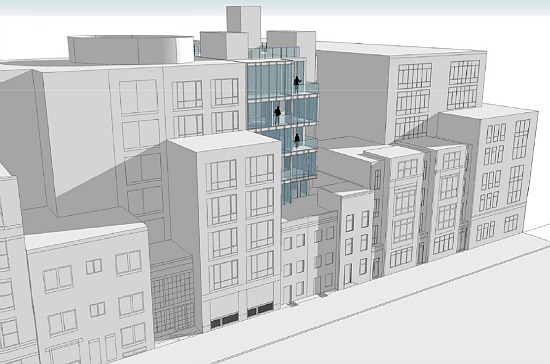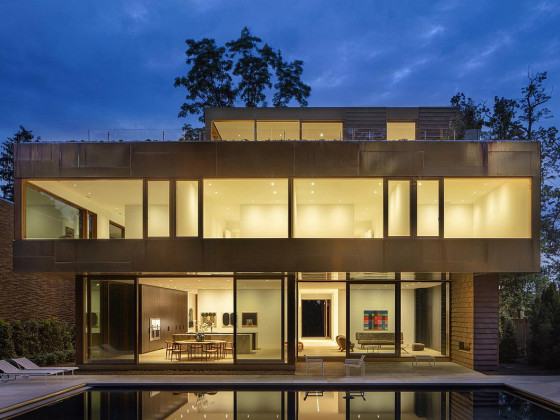 Logan Circle Micro-Units Eke Out Support from Zoning
Logan Circle Micro-Units Eke Out Support from Zoning
✉️ Want to forward this article? Click here.

An earlier rendering of the development, facing Church Street NW. Peter Fillat.
It’s finally happening.
After nearly a year of back-and-forth with a divided Board of Zoning Adjustment (BZA), developers Gregg Busch and Brook Rose received the final variance they needed to continue with the micro-unit project planned for 1456-1460 Church Street NW (map) on Tuesday. The motion to approve a parking variance was put forward not by BZA chairman Lloyd Jordan, but by member Peter May, and passed by a vote of 3-2.
In the wake of the decision, the developers told UrbanTurf that they were “regrouping” and planned to start construction in 3-4 months on the 27-unit project. Once started, construction should take 9 months to a year to complete, indicating a late 2015 delivery of the project.
“We’re clearly very pleased with the decision,” Brook Rose said. “It’s been a long process and we’re happy to now be able to move forward. It’s been so long that we put everybody on hold. It’s definitely slowed down the momentum of the project, but we’re excited to get started.”
Jordan and Kathryn Allen, the board’s vice chairperson, dissented. Jordan said he wasn’t convinced the developer’s mitigation — including providing four parking spaces in the back of the project, two guest parking spaces in nearby parking lots, and car and bike share memberships for the duration of every new tenant’s lease — was enough. May disagreed, saying those measures were “on the more generous end” of what developers typically offer to mitigate a lack of parking.
The development is on a narrow lot with three historic structures Busch and Rose are preserving. Because of that, building a parking garage underneath the development isn’t feasible.

An early rendering of the Church Street project as seen from the back. Courtesy of Peter Fillat.
The board was very obviously divided on the project at the outset of Tuesday’s meeting. Jordan said he wanted the developers to negotiate with nearby parking garages to obtain five more parking spaces at reduced rates for tenants and provide the car and bike shares for every tenant in perpetuity. Those provisions would likely have delayed the BZA’s decision further.
“Generally speaking, I am personally a stickler when it comes to the zoning regulations,” May said. “I don’t venture into unproven territory when it comes to granting relief. … I do not believe that granting this relief is going beyond the authority of the BZA. I think it’s perfectly within it.”
May moved to vote on the project immediately, while Jordan tried to make a case for more parking and extended car and bike share provisions.
“I don’t support continuing the motion any further,” May finally said. The board then voted.
Busch and Rose’s plan had received support from DDOT, ANC 2F, the Historic Preservation Review Board and the Office of Planning prior to appearing before the BZA.
Jordan said one of the biggest sticking points in his decision was a lack of evidence about what impact the development would have on the surrounding area. However, a transportation specialist hired by the developer told the board that without any mitigation, the project would contribute about a 1 percent increase in traffic to the area. With mitigation, the specialist said they believed there would be no increase to the area’s traffic.
“I think we’re not being realistic that every person is going to take public transportation,” Jordan said, suggesting some residents may work in neighborhoods like Tysons Corner and require a car. “I think that is just nuts.”
Busch and Rose plan to bar tenants from applying for residential parking permits (RPPs) in their lease, which, as we’ve noted previously, is difficult to enforce under current District regulations. However, they go further than most in their attempts to enforce the RPP restriction. They will require tenants to sign a release allowing the DMV to provide the developers details on whether they apply for RPPs. The developers will then request that information once or twice a year and evict any tenants who applied for a permit.
May said that if DC can’t enforce RPP restrictions, that isn’t a problem for developers to solve.
“I believe RPPs are a necessary tool for mitigation,” he said. “If there are issues with that working properly, they are on the administrative side and must be fixed.”
See other articles related to: logan circle, micro units, micro-units, microunits, parking
This article originally published at http://dc.urbanturf.production.logicbrush.com/articles/blog/logan_circle_micro-units_eke_out_support_from_zoning/8626.
Most Popular... This Week • Last 30 Days • Ever

With frigid weather hitting the region, these tips are important for homeowners to ke... read »

A new report from DC’s Office of Revenue Analysis highlights how millennials and wo... read »

The building is the second proposal for a pair of aging office buildings in downtown ... read »

The number of neighborhoods in DC where the median home price hit or exceeded $1 mill... read »

The DC-area housing market hit a sluggish patch in November, according to the latest ... read »
DC Real Estate Guides
Short guides to navigating the DC-area real estate market
We've collected all our helpful guides for buying, selling and renting in and around Washington, DC in one place. Start browsing below!
First-Timer Primers
Intro guides for first-time home buyers
Unique Spaces
Awesome and unusual real estate from across the DC Metro














